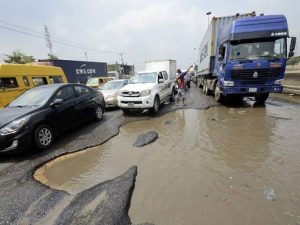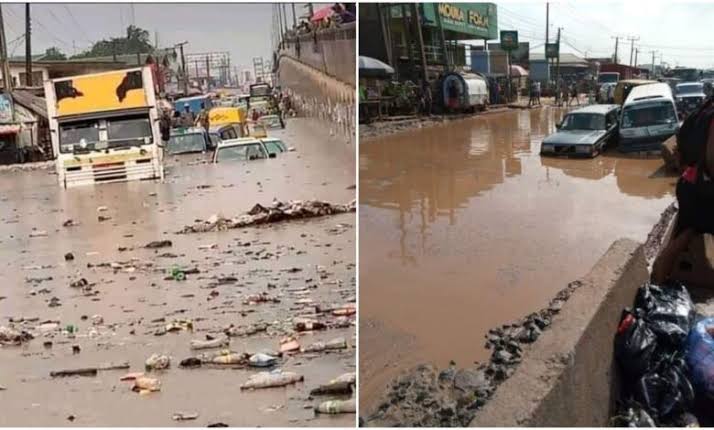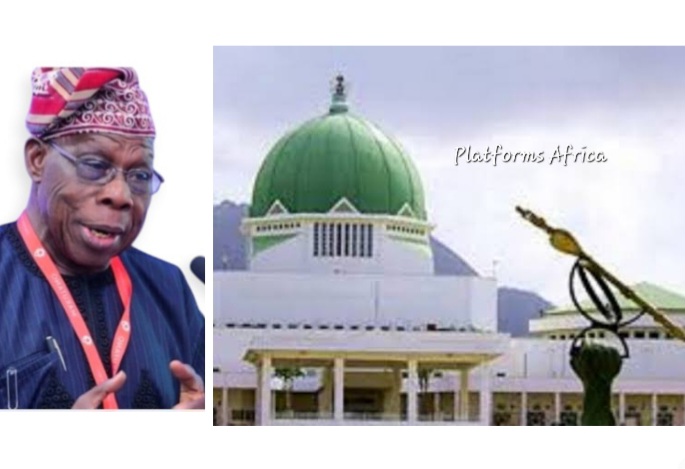From Oju-Ore to Atan through Iyana Iyesi, the government generates taxes and levies with which it powers the generator at the government house in Oke-Mosan, erects bridges in Panseke, paves the dusty roads through Ijebu-Ode, equips hospitals in Iyana Mortuary, breathe life into old housing estates in Oke Ilewo, and transforms schools in Odogbolu.
Here lies the road to Sango-Ota, in all its filth and sludge, reeking of the lies of scheming politicians. It’s a major road that leads everywhere, and yet it leads nowhere. It’s the metaphor of the artery as dead end, a highway to no way. A trip along the road is like a journey across the valley of the shadow of death.
Ota itself is a paradox in absurdity, a Borokini in smelly rags. From the industrial town, Ogun State gathers perhaps the biggest of revenues that serve as budgetary elixir every month. From Oju-Ore to Atan through Iyana Iyesi, the government generates taxes and levies with which it powers the generator at the government house in Oke-Mosan, erects bridges in Panseke, paves the dusty roads through Ijebu-Ode, equips hospitals in Iyana Mortuary, breathe life into old housing estates in Oke Ilewo, and transforms schools in Odogbolu. But here in the heart of Ota, little children limp to school through broken gutters and mire, while old men in flooded homes cry from dawn to dusk whenever it rains.
READ ALSO: JUST IN: Lagos Shuts Dowen College Over 12 yr-old Student’s Death, Cultism
Obafemi Awolowo Varsity Honours Buhari’s Aide, Femi Adesina, 59 Other Alumni
16 Year-Old WAEC Candidate Diagnosed with Brain Tumour, Parents Crave Help
Top Pastors, Banks’ CEOs Affected as Nigeria Grounds 91 Private Jets
For years, the subject of who takes responsibility for Ota roads has been a game of chess between Ogun and the FG. Principally because the decay spreads onto sections of the Lagos-Abeokuta expressway and the Ota-Idiroko road, both federal highways, local politicians played hide-and-seek with their fingers, while the people sucked into the shadows.
And so Ota remained in filth and muddy earth, even in the midst of abundance.

When I returned to journalism after my stint in Unilorin, I lived briefly on that axis. And I saw how basic things could make the difference between a people’s journey to poverty or prosperity. Whenever I had assignments on the Island tossed my way by editors, my heart sank. Commuting to Isale-Eko from that axis was hell, literally, and things weren’t even as bad as they now are.
The road, like the home, shapes our daily itinerary. The road paves the way to places where we toil to make money, or fetch water and bread and sardine to the dinning table, or provide books and chocolate for the kids, or mingle and meet with fiends and friends, or feed the gluttony of constituted authorities with taxes and bills. If we don’t till, we can’t pay bills. And if we don’t ply the road, we can’t till. Yet, strangely in certain instances, the road doesn’t get as much attention as the home.
At the heart of Ota story of forgotten roads are the identity of politics and politics of identity. It’s the nature of our local politics that winners take the largest chunk of the bounty of victory, or even, all of it. It is what inspired Buhari’s 97% rhetoric against the East; it is why overhead bridges rose from dust in Abeokuta while, in contrast, Ota stumbled in muddy earth during the Amosun years.
The potency of identity politics isn’t lost on the sons and daughters of Ota, and by extension, Ogun West. For eons, that district has been at the vanguard of having “their son” planted at Oke-Mosan. It hasn’t yielded result. Since 1999, the guber baton has exchanged hands between the Egbas and the Ijebus.
First, there was the charismatic Aremo ‘Segun Osoba, who barely met the people’s gigantic expectations in the wake of the Khaki boys’ departure in 1999. In 2003, Aremo fell for the gambit of the old fox, Olusegun Obasanjo, and was pushed out of Oke-Mosan. Then sauntered in Otunba Gbenga Daniel, a.k.a OGD, whose arrival came with gongs and Sekere and chants of ‘Ogidi Omo!’ Daniel was re-elected in 2007 on the strength of an impressive performance, but he exited the stage in 2011 with less ovation, leaving behind security concerns with macabre twists. Then came the man with the skyscraper cap, Ibikunle Amosun, who turned his Abeokuta hometown into a museum of bridges, and left Akute and Lambe and Ijoko and Alagbole with carcasses of decaying projects. After Amosun came the man with boyish swagger, Prince Dapo Abiodun.
Daniel is Ijebu, and so is Dapo; Amosun is Egba, just like Osoba. Both districts have enjoyed democratic dividends since 1999, to a significant extent. But like their offsprings in Lagos and elsewhere, what ails the Aworis of Ogun is what ails the Yewa/Egbados. They are pariahs in the seats of power, their communities backwaters of illiteracy and poverty. Between the Osoba and Abiodun years, there have been attempts by big names from Ogun West, part of which Ota falls, to capture power and inspire home-grown development.
There was the urbane Gboyega Nasiru Isiaka, a.k.a GNI, the golden son of Imeko, who burst onto the scene as Daniel’s sidekick. A mixed bag of a scheming principal’s records of service blurred by megalomaniac tendency shut him away from the golden prize. There is the boyish AbdulKabir Akinlade, with whom Amosun attempted the birth of a dynasty. Even though both men thrust forward to appeal to the sentiment of the West, they failed to achieve the dynastic intents of their principals.
And so as the campaigns for ‘Omo West’ crumbled in each election cycle since 2011, the roads in Ota, a major focus in campaign rhetoric, remained in shambles.
In The Famished Road, novelist Ben Okri explores the mystique of the road – the myth that Azaro’s father tells him about the “King of the Road”, who was always famished. Okri seems to have borrowed a bit of the wisdom of the Yoruba. May we not tread the road on days it is famished, the Yoruba would say. Yet Ota roads are right in the heart of Yorubaland, famished and crying for attention. The roads are reeling in muddy earth, begging for asphalt concrete, black gravel, mineral powder and bitumen.
And as in Ben Okri’s, it’s a case of classic absurdity that, until recently when works began on the Agbara-Atan road after years of neglect, Ogun hosted a number of such poor roads, including those under the gaze of the government at the centre, despite donating the most to Aso Rock among states across Yorubaland.
Think Obasanjo. Think Osinbajo.
The other day, activist Hassan Soweto made a most eloquent case for the rehabilitation of Ota roads. I listened to him and was quite touched and agitated. His was emotion and logic rising and falling in perfect symphony. Before him, rap artiste Eedris Abdulkareem also brought the issue to the radar, although the man who sang Jaga-jaga couldn’t inspire much hope about a road whose condition now mirrors his 2004 hit, partly because of the artiste’s own battle with obscurity. But in the end, both artiste and activist sang their names into Ota lore, and history would be kind to them.
Now works have begun on some sections of the Lagos-Abeokuta expressway, notably from Lagos through Toll-Gate, but it’s been quite skeletal. We hear also that the Minister of Works, Babatunde Fashola, has gotten approval for the rehabilitation of other sections, and that billonaire Mike Adenuga would take charge of sections along the equally delapidated Ota-Idiroko corridor. Cheery stuff. One hopes that lawmakers and influential figures from the axis would join in the campaign for actual execution of those plans.
It’s the curse of our type of federalist structure that, perhaps because it takes so much, we focus too much on the centre, leaving the state to get away with serial iniquities. Yet apart from the federal roads, which have generated considerable interests in recent weeks, the inner roads in Ota axis are in more deplorable conditions. From Sango to Ijoko, there is a major road that links Berger and Akute through Agbado Crossing and Lambe, but it’s in complete shambles. A part of the section stretching into Ijoko and Ogba-Ayo was constructed during the Amosun years, while the other part remained abandoned. Four or so years on, both parts are now a complete mess.
Like in Ajuwon and Ojodu Abiodun, there have been attempts to bring temporary relief in Sango-Ota, through what the government called “palliative” interventions, but like investigative journalist Nicholas Ibekwe observed in a chat the other day, such efforts often disappear into the dust after few weeks. The only road that provides succor in Ota now is the super-busy road that stretches into Meiran and Abule Egba, through Command area, constructed by the Lagos State Government.
Governor Abiodun recently said his government was shopping for some N13bn to fix those roads and provide decent housing schemes in Ilaro, Ijebu and Ota. But the governments, both in Abeokuta and Abuja, would have to go beyond talks and weak promises. These promises have become sweet nothings to the ears of people in homes and bars and brothels in Ota and environs. They are now like rhymes without rhythm, worn out and tired cliches.
From Dalemo through Gas-line, Ota people are disenchanted, just like their neighbours in Akute, Ijoko, Ajuwon, Agbado, Lambe, parts of Oke-Aro, and elsewhere. Only smooth roads can bring hope alive. There wouldn’t be hope until the governments lay asphalt on tiring rhetoric. Tick, tock, tick…
****
Oladeinde tweets via @ola_deinde





